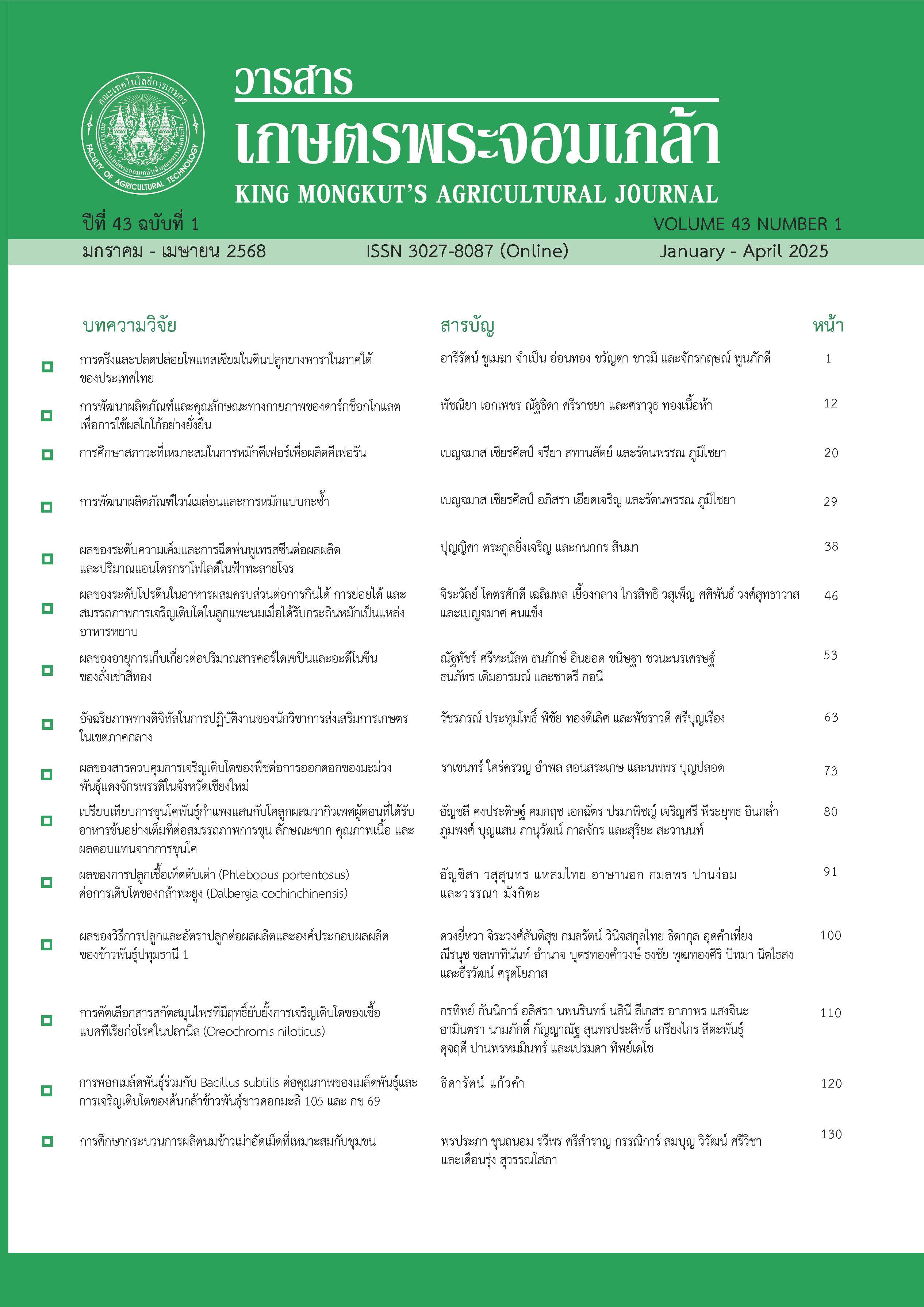Effects of Protein Levels in Total Mixed Rations on Feed Intake Digestibility and Growth Performance in Dairy Goats when Fed with Leucaena leucocepphala Silage as Roughage Source
Main Article Content
Abstract
This experiment aimed to study the effects of protein levels in total mixed rations on feed intake digestibility and growth performance in dairy goats when fed with Leucaena leucocepphala silage as roughage source. Eight goats (four females and four males) were divided into two groups (each group consisted of two female and two male goats). There were two treatment groups; T1 = 8.0% CP in total diet and T2 = 10% CP in total diet. Leucaena silage was used as a roughage source. The ratio between roughage to concentrate was set at 40:60. The results showed that protein level in mixed ration affecting the feed intake, average daily gain, and feed conversion had no statistically significant difference (P>0.05). When the goats were fed with total mixed rations (TMR) containing high and low protein, the feed intakes were 708 and 678 gDM/d, respectively. The average daily gain in goats that were fed with TMR containing high and low protein were 100.80 and 112.90 g/d, respectively (P>0.05), and the feed conversion ratio (FCR) in goats were 6.96 and 6.57, respectively (P>0.05). Based on experimental data, it can be concluded that protein level in total mixed ration did not influence feed intake, average daily gain, feed conversion ratio and nutrient digestibility in dairy goats fed with Leucaena silage as a roughage source.
Article Details

This work is licensed under a Creative Commons Attribution-NonCommercial-NoDerivatives 4.0 International License.
King Mongkut's Agricultural Journal
References
AOAC. (1990). Official Methods of Analysis. 15th Ed. Association of Official Analytical Chemist.
Cherdthong, A., Rakwongrit, D., Saising, T., Wachirapakorn, C., Haitook, T., Khantharin, S., Wongphitak, K, Tangmutthapattharakun, G., Seankamsorn, A., & Supapong, C. (2016). Effect of concentrate levels and protein source supplementation in Thai native cattle on intake, rumen fermentation and average daily gain. Khon Kaen Agriculture Journal, 44(Suppl 1), 540-545. (in Thai).
Chewprecha, W., Paladpom, A., Singpol, W., Chopamitkun, P., Ruangprim, T., & Sawanon, S. (2012). Effect of Leucaena (Leucaena leucocephala) supplementation on feedlot performance, carcass characteristic and production cost of Kamphaengsaen steers. In Proceedings of 50th Kasetsart University Annual Conference: Animals, Veterinary Medicine, Fisheries, pp. 144-152. The Thailand Research Fund, Bangkok. (in Thai).
Derakhshani, H., Corley, S. W., & Jassim, R. (2016). Isolation and characterization of mimosine, 3, 4 DHP and 2,3 DHP degrading bacteria from a commercial rumen inoculum. Journal Basic Microbiology, 56(5), 580-585.
Devendra, C., & Burns, M. (1983). Goat Production in Tropics. 2nd Commonwealth Agricultural Bureau, Farnham House: Farnham Royal.
Harun, N. L. A., Alimon, A. R., Jahromi, M. F., & Samsudin, A. A. (2017). Effects of feeding goats with Leucaena leucocephala and Manihot esculenta leaves supplemented diets on rumen fermentation profiles, urinary purine derivatives and rumen microbial population. Journal of Applied Animal Research, 45(1), 409-416.
Maksiri, W., Tudsri, S., Thiengtham, J., & Prasanpanich, S. (2017). Supplementation of forage sorghum with meal concentrate and Leucaena leucacephala on goat performance with particular reference to meat essential fatty acid contents. Agricultural Technology and Biological Sciences, 14(11), 855-864.
Morgan, D. E., & Barber, W. P. (1979). The advisor’s approach to predicting the metabolizable energy value of feeds for ruminants. In Recent Advances in Animal Nutrition, pp. 93-106. Faculty of Agricultural Sciences, University of Nottingham.
NRC. (1981). Feeding Value of Ethanol Production By-Products. Committee on Animal Nutrition. National Academy Press.
Polsiri, N., Padunglerk, A., & Kongmun, P. (2012). Study of feedlot efficiency in goat meat by using dry Leucaena leucocephala. In Proceedings of 53rd Kasetsart University Annual Conference: Plants, Animals, Veterinary Medicine, Fisheries, Agricultural Extension and Home Economics, pp. 769-776. Kasetsart University. (In Thai).
Pralomkarn, W. (1995). Feed and Feeding of Goats. Department of Animal Science Faculty of Natural resources, Prince of Songkla University.
Romero, J. J., Zarate, M. A., Ogunade, I. M., Arriola, K. G., & Adesogan, A. T. (2018). Tropical plant supplementation effects on the performance and parasite burden of goats. Asian-Australia Journal of Animal Sciences, 31(2), 208-217.
Saha, H. M., Kahindi, R. K., & Muinga, R. W. (2008). Evaluation of manure from goats fed Panicum basal diet and supplemented with Madras thorn, Leucaena or Gliricidia. Tropical Subtropical Agroecosystem, 8(3), 251-257.
Semae, S., & Kraiprom, T. (2018). Effects of Leucaena (Leucaena leucocephala) as roughage source on goat performance and economic worthiness. Prince of Naradhiwas University Journal, 10(2), 140-146. (in Thai).
Sharma, N., Sharma, K. P. Gaur, R. K., & Grupta, V. K. (2011). Role of chitinase in plant defense. Asian Journal Chemistry, 6(1), 29-37.
Steel, R. G. D., & Torrie, J. H. (1980). Principle and Procedures of Statistics. 2nd Ed. McGraw-Hill Book Company.
Vasupen, K., Yuangklang. C., Sarnklong, C., Wongsuthavas, S., Mitchaothai, J., & Srenanul, P. (2006). Effects of total mixed ration and fermented total mixed ration on voluntary feed intake, digestion nutrients digestibility, and milk production in lactating dairy cows. Khon Kaen Agriculture Journal, 34(1), 75-82.
Van Soest, P. J., Robertson, J. B., & Lewis, B. A. (1991). Methods for dietary fiber, neutral detergent fiber, and non-starch polysaccharides in relation to animal nutrition. Journal of Dairy Science, 74(10), 3583- 3597.
Yuangklang, C., Vasupen, K., Wittayakun, S., Srinanaun, P., & Sukho, C. (2004). Effect of total mixed ration and fermented total mixed ration on feed intake, ruminal fermentation, nutrient digestibility and blood metabolites in dairy cows. In Proceeding of the 11th AAAP Congress “New Dimensions and Challenges for Sustainable Livestock Farming” The Asian-Australasian Association of Animal Production Societies, pp. 18-20. Malaysian Society of Animal Production.
Zayed, M. Z., Sallam, S. M. A., & Shetta, N. D. (2018). Review article on Leucaena leucocephala as one of the miracle timber trees. International Journal of Pharmacy and Pharmaceutical Sciences, 10(1), 1-7.


